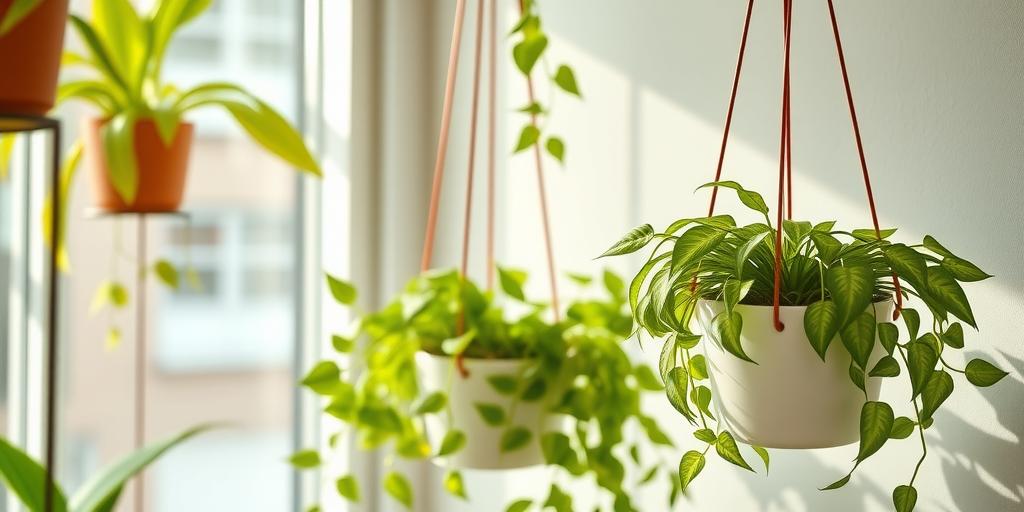
DIY Hanging Planters for Low Light Plants: Creative Ideas to Brighten Your Space
Discover creative DIY hanging planter ideas for low-light plants! From macramé to upcycled containers, learn how to stylishly display shade-loving greenery in your home.
Introduction
Did you know that low-light plants like pothos, snake plants, and ferns can thrive even in the dimmest corners of your home? But why settle for boring pots when you can create stunning DIY hanging planters that add charm and greenery to any space? Whether you’re a plant newbie or a seasoned green thumb, this guide will walk you through unique, budget-friendly ways to showcase your low-light plants in style. Let’s get crafting!
Why Choose Hanging Planters for Low Light Plants?
Hanging planters are a fantastic solution for low-light plants, especially if you’re working with limited space. Many shade-loving plants thrive when suspended, as it allows them to receive filtered light from different angles. Plus, vertical gardening helps keep your floors and surfaces clutter-free while still bringing greenery into your home.
One of the biggest perks? Improved air circulation. Low-light plants often struggle with stagnant air, which can lead to mold or pests. Hanging them ensures better airflow around the leaves and soil, keeping them healthier. And let’s not forget the aesthetic benefits—hanging planters add depth and texture to dull corners, turning them into lush focal points.
Best Low Light Plants for Hanging Planters
Not all plants are suited for hanging baskets in low-light conditions, but some thrive in these environments. Here are a few top picks:
-
Pothos – Nearly indestructible, pothos vines beautifully and tolerates neglect. Let the soil dry slightly between waterings.
-
Spider Plant – Produces cascading baby “spiderettes” and prefers slightly moist soil. Great for beginners.
-
Philodendron – Heart-shaped leaves trail elegantly. Water when the top inch of soil is dry.
-
English Ivy – Loves humidity and indirect light. Mist occasionally to keep it happy.
When pairing plants with planters, consider weight and drainage. Lightweight plastic or fiberglass planters work well for larger trailing plants, while ceramic or macramé holders suit smaller, delicate species.
Creative DIY Hanging Planter Ideas
1. Macramé Hanging Planters
Macramé adds a boho-chic touch to any space. If you’re new to knotting, start with a simple square knot pattern—plenty of tutorials make it easy! Cotton rope is the most beginner-friendly, but jute or synthetic cords work too. Customize the length based on your ceiling height—longer hangers create drama, while shorter ones keep plants at eye level.
2. Upcycled Container Planters
Turn everyday items into unique planters! Mason jars, tin cans, or even old teacups can become charming homes for small plants. Just drill a few drainage holes (use a glass/tile bit for jars). Sand rough edges, then paint or decorate with waterproof sealant for a cohesive look.
3. Geometric Wooden Hanging Planters
For a modern twist, try building a wooden frame. Cedar or teak are durable choices that resist moisture. Cut pieces into triangles or hexagons, assemble with wood glue and nails, then stain or seal for indoor/outdoor use. Hang with sturdy twine or metal chains.
4. Hanging Terrariums for Low Light Plants
Glass terrariums are perfect for humidity-loving plants like ferns or moss. Use open containers for airflow, and layer gravel, soil, and moss before planting. Avoid overwatering—terrariums trap moisture, so a light misting is often enough.
5. Wall-Mounted Hanging Planters
Maximize vertical space with wall-mounted options. Pegboards, floating shelves, or simple hooks let you arrange multiple planters in a living wall effect. For heavier planters, use drywall anchors or mount directly into studs. Lightweight options like plastic or felt hangers work well for small plants.
Essential Tips for Maintaining Hanging Low Light Plants
Even low-maintenance plants need some TLC. Here’s how to keep them thriving:
-
Watering – Check soil moisture with your finger. Many low-light plants prefer slightly dry conditions—overwatering is a common killer.
-
Fertilizing – Use a diluted, balanced fertilizer every 4-6 weeks during growing season. Slow-growing plants need less frequent feeding.
-
Rotating – Turn plants occasionally so all sides get even light exposure, preventing lopsided growth.
-
Pest Prevention – Keep leaves dust-free and inspect regularly. Neem oil or insecticidal soap helps combat spider mites or mealybugs.
By choosing the right plants, getting creative with DIY hangers, and following these care tips, you can turn any dim corner into a thriving green oasis. Happy planting!
Conclusion
Hanging planters are a fantastic way to bring life to dim corners while showcasing your creativity! Whether you opt for bohemian macramé, rustic upcycled jars, or sleek geometric designs, there’s a DIY solution for every style. Ready to transform your space? Pick your favorite idea and start crafting today—your low-light plants will thank you!
